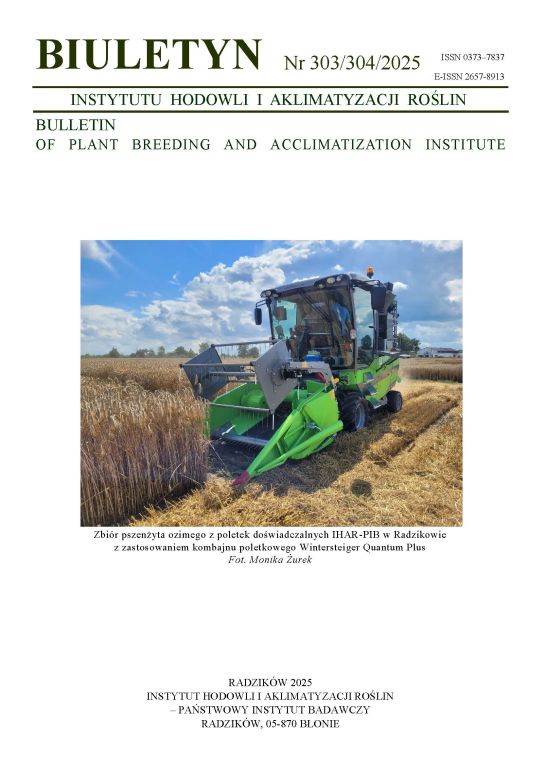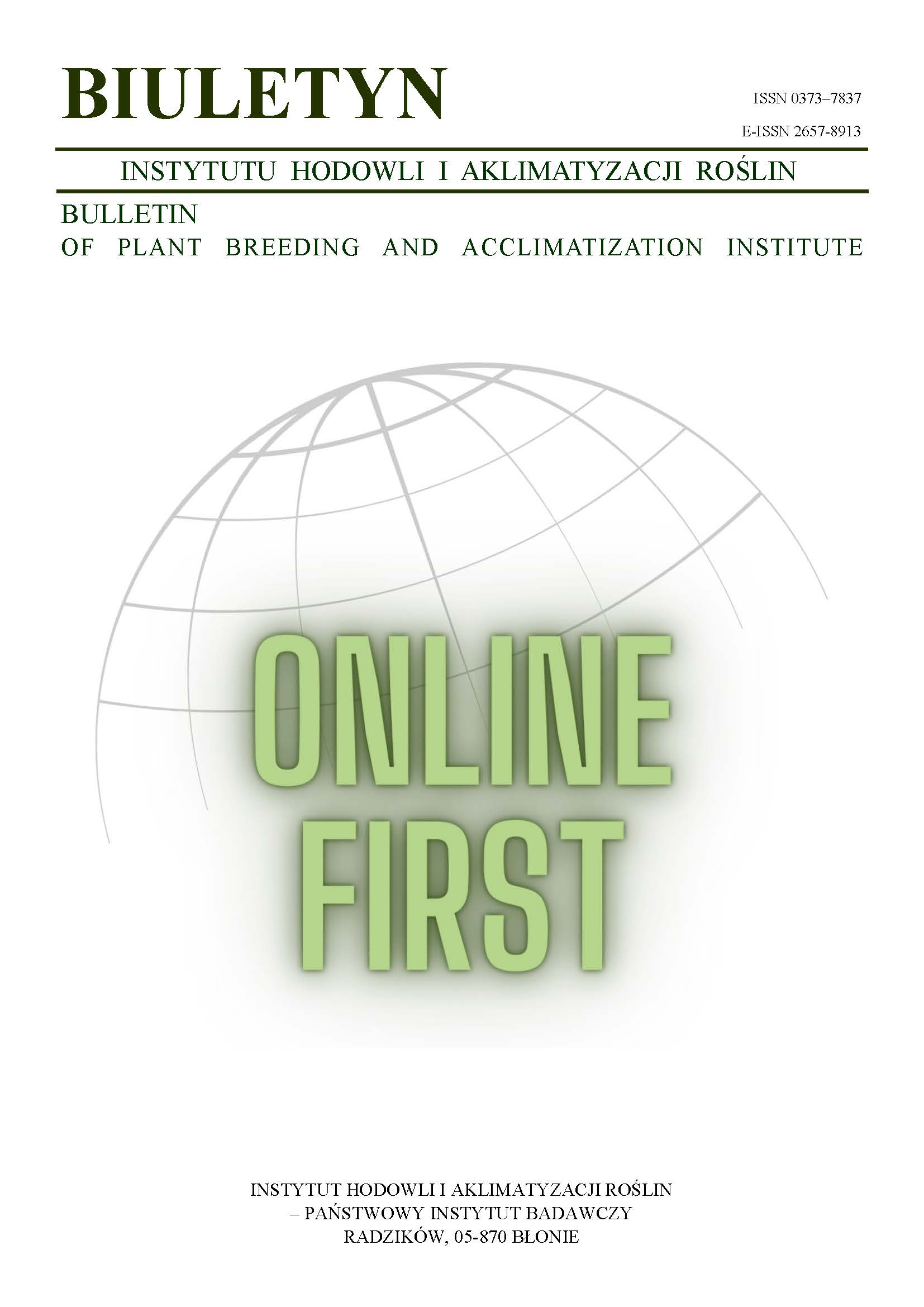Choroby bakteryjne ziemniaka (Solanum tuberosum L.) — strategie ochrony
Renata Lebecka
r.lebecka@ihar.edu.plZakład Genetyki i Materiałów Wyjściowych Ziemniaka, Instytut Hodowli i Aklimatyzacji Roślin, Oddział Młochów (Poland)
Ewa Zimnoch-Guzowska
Zakład Genetyki i Materiałów Wyjściowych Ziemniaka, Instytut Hodowli i Aklimatyzacji Roślin, Oddział Młochów (Poland)
Abstrakt
Omówiono występowanie i znaczenie ważniejszych chorób bakteryjnych ziemniaka. Dokonano porównania reakcji ziemniaka na porażenie przez bakterie wywołujące czarną nóżkę ziemniaka i mokrą zgniliznę, bakteriozę pierścieniową i śluzaka. Omówiono strategie ochrony ziemniaka przed tymi chorobami.
Słowa kluczowe:
czarna nóżka, bakterioza pierścieniowa, mokra zgnilizna, śluzak, odpornośćBibliografia
Bain R. A., Pérombelon M. C. M., Tsror L., Nachmias A. 1990. Blackleg development and tuber yield in reaction to numbers of Erwinia carotovora subsp. atroseptica on seed tubers. Plant Pathol. 39: 125 — 133.
DOI: https://doi.org/10.1111/j.1365-3059.1990.tb02483.x
Google Scholar
Bergey D. H., Harrison F. C., Breed R. S., Hammer B. W., Huntoon F. M. 1923. In: Bergey's Manual of Determinative Bacteriology, 1st ed., The Williams & Wilkins Co, Baltimore: 1 — 442.
Google Scholar
Bugbee W. M., Gudmestad N. C. 1988. The recovery of Corynebacterium sepedonicum from sugarbeet seed. Phytopathology 78: 205 — 208.
DOI: https://doi.org/10.1094/Phyto-78-205
Google Scholar
Burkholder W. H., McFadden L. A., Dimock A. V. 1953. A bacterial blight of chrysanthemums. Phytopathology 43: 522 — 526.
Google Scholar
Carputo D., Cardi T., Speggiorin M., Zoina A., Frusciante L. 1997. Resistance to blackleg and tuber soft rot in sexual and somatic interspecific hybrids with different background. Am. Potato J. 74: 161 — 172.
DOI: https://doi.org/10.1007/BF02851595
Google Scholar
Chakrabarti S. K., Gadewar A. V., Gopal J., Shekhawat G. S. 1994. Performance of tetraploid × diploid (TD) crosses of potato for bacterial wilt resistance in India. ACIAR Bacterial Wilt Newsl. 10: 7.
Google Scholar
Davis M. J., Gillaspie A. G., Vidaver A. K., Harris R. W. 1984. Clavibacter: a new genus containing some phytopathogenic coryneform bacteria, including Clavibacter xyli subsp. xyli sp. nov., subsp. nov, and Clavibacter xyli subsp. cynodontis, subsp. nov., pathogens that cause ratoon stunting disease of sugarcane and bermudagrass stunting disease. Int. J. Syst. Bacteriol. 34: 107 — 117
DOI: https://doi.org/10.1099/00207713-34-2-107
Google Scholar
De Maine M. J., Lees A. K., Muir D. D., Bradshaw J. E., Mackay G. R. 2000. Long-day-adapted Phureja as a resource for potato breeding and genetic research. Potato Global Research and Development. Proceedings of the Global Conference on Potato, S. M. P. Khurana, G. S. Shekhawat, B. P. Sing, S.K. Pandey (eds.). New Delhi, India, 6–11.12.1999: 134 — 137.
Google Scholar
Dye D. W. 1969. A taxonomic study of the genus Erwinia. II. The "carotovora" group. New Zealand J. Sci. 12: 81 — 97.
Google Scholar
Easton G. D. 1979. The biology and epidemiology of potato ring rot. Am. Potato J. 56: 459 — 460.
Google Scholar
Elsas van J. D., van Overbeek L. S., Smalla K., Bailey M. J., Trigalet A., Marco Y., Lopes M. M. 2002. The fate, activity and spread of R. solanacearum biovar 2 in European habitats. Book of Abstracts of 3rd International Bacterial Wilt Symposium, 4–8.02.2002, South Africa: 5 p.
Google Scholar
Elsas van J. D., Kastelein P., van Bekkum P., van der Wolf J. M., de Vries P. M., van Overbeek L. S. 2000. Survival of Ralstonia solanacearum biovar 2, the causative agent of potato brown rot, in field and microcosm soils in temperate climates. Phytopathol. 90: 1358 — 1366.
DOI: https://doi.org/10.1094/PHYTO.2000.90.12.1358
Google Scholar
Fock I., , Luisetti J., Collonier C., Vedel F., Ducreux G., Kodja H., Sihachakr D. 2002. Solanum phureja and S. stenotomum as sources of resistance to Ralstonia solanacearum in somatic hybrids of potato. Book of Abstracts of 3rd International Bacterial Wilt Symposium 4–8.02.2002, South Africa: 47 pp.
Google Scholar
French E. R., Anguiz R., Aley P. 1997. The usefulness of potato resistance to Ralstonia (Pseudomonas) solanacearum for the integrated control of bacterial wilt. II conference IBWS: Disease Management, 22–27 June 1997, Guadelupe.
DOI: https://doi.org/10.1007/978-3-662-03592-4_58
Google Scholar
Gamard P., de Boer S. H. 1995. Evaluation of antagonistic bacteria for suppression of bacterial ring rot. Europ. J. Plant Pathol. 101: 519 — 525.
DOI: https://doi.org/10.1007/BF01874476
Google Scholar
Hartman G. L., Elphinstone J. G. 1994. Advances in the control of Pseudomonas solanacearum race 1 in major food crops. Bacterial wilt. The disease and its causative agent, Pseudomonas solanacearum. A. C. Hayward and G. L. Hartman (eds.). CAB International, Wallingford, U.K.: 157 — 177.
Google Scholar
Hauben L., Moore E. R. B., Vauterin L., Steenackers M., Verdonck L., Swings J. 1998. Phylogenetic position of phytopathogens within the Enterobacteriacae. Syst. Appl. Microbiol. 21:384 — 397.
DOI: https://doi.org/10.1016/S0723-2020(98)80048-9
Google Scholar
Hayward A. C. 1991. Biology and epidemiology of bacterial wild caused by Pseudomonas solanacearum. Annu. Rev. Phytopathol. 29: 65 — 87.
DOI: https://doi.org/10.1146/annurev.py.29.090191.000433
Google Scholar
Helgeson J. P., Haberlach G. T., Ehlenfeldt M. K., Hunt G., Pohlman J. D. , Austin S. 1993. Sexual progeny of somatic hybrids between potato and Solanum brevidens: potential for use in breeding programs. Am. Potato J. 70: 437 — 452.
DOI: https://doi.org/10.1007/BF02849063
Google Scholar
Hide G. A., Welham S. J., Read P. J., Ainsley A. E. 1996. The yield of potato plants as affected by stem cancer (Rhizoctonia solani), blackleg (Erwinia carotovora subsp. atroseptica) and by neighboring plants. J. Agr. Sci. 126: 429 — 440.
DOI: https://doi.org/10.1017/S0021859600075511
Google Scholar
Huaman Z., de Lindo L., Elphinstone J. G. 1988. Resistance to blackleg and soft rot and its potential use in breeding. Report of the Planning Conference on bacterial Diseases of the Potato 1987, E. R. French (ed.). International Potato Center, Lima, Peru: 215 — 228.
Google Scholar
Ishimaru C. A., Lapitan N. L., VanBuren A., Fenwick A., Pedas K. 1994. Identification of parents suitable for molecular mapping of immunity and resistance genes in Solanum species. Am. Potato J. 71: 517 — 533.
DOI: https://doi.org/10.1007/BF02851324
Google Scholar
Iwanaga M. 1985. Ploidy level manipulation approach development of diploid populations with specific resistance and FDR 2n pollen production. Report of the 26th Planning Conference: Present and future strategies for potato breeding and improvement. 12–14 December 1983. International Potato Center, Lima, Peru: 57 — 70.
Google Scholar
Janse J. D. 1988. A detection method for Pseudomonas solanacearum in symptom less potato tubers and some data on its sensitivity and specificity. EPPO/OEPP Bulletin 18: 343 — 351.
DOI: https://doi.org/10.1111/j.1365-2338.1988.tb00385.x
Google Scholar
Kinyua Z. M., Smith J. J., Lung’aho C., Olanya M., Priou S. 2001. On-farm successes and challenges of producing bacterial wilt-free tubers in seed plots in Kenya. African Crop Sci. J. 9: 279 — 285.
DOI: https://doi.org/10.4314/acsj.v9i1.27649
Google Scholar
Kriel C. J., Jansky S.H., Gudmestad N. C., Ronis D. H. 1995. Immunity to Clavibacter michiganensis subsp. sepedonicus: screening of exotic Solanum species. Euphytica 82: 125 — 132.
DOI: https://doi.org/10.1007/BF00027058
Google Scholar
Laferriere L. T., Helgeson J. P., Allen C. 1999. Fertile Solanum tuberosum plus somatic hybrids as sources of resistance to bacterial wilt caused by Ralstonia solanacearum. Theor. Appl. Genet. 98: 1272 — 1278.
DOI: https://doi.org/10.1007/s001220051193
Google Scholar
Laurila J., Metzler M. C., Ashimaru C A., Rokka V. M. 2003. Infection of plant material derived from Solanum acaule with Clavibacter michiganensis subsp. sepedonicus: temperature as a determining factor in immunity of S. acaule to bacterial ring rot. Plant Pathol. 52: 496 — 504.
DOI: https://doi.org/10.1046/j.1365-3059.2003.00866.x
Google Scholar
Lebecka R., Zimnoch-Guzowska E., Kaczmarek Z. 2004. Resistance to soft rot (Erwinia carotovora subsp. atroseptica) in tetraploid potato families obtained from 4x-2x crosses. Am. J. Potato Res. 82: 107 — 114.
DOI: https://doi.org/10.1007/BF02853586
Google Scholar
McLaughlin R. J., Sequeira L. 1988. Evaluation of an avirulent strain of Pseudomonas solanacearum for biological control of bacterial wilt of potato. Am. Potato J. 65: 255 — 268.
DOI: https://doi.org/10.1007/BF02854051
Google Scholar
Mills D., Russell B. W., Hanus J. W. 1997. Specific detection of Clavibacter michiganensis subsp. sepedonicus by amplification of three unique DNA sequences isolated by subtraction hybridization. Phytopathology 87: 853 — 861.
DOI: https://doi.org/10.1094/PHYTO.1997.87.8.853
Google Scholar
Montanelli, C., Stefanini F. M, Chiari A., Chiari T., Nascari G. 1995. Variability in the response to Pseudomonas solanacearum of transgenic lines of potato carrying a cecropin gene analogue. Potato Res. 38: 371 — 378.
DOI: https://doi.org/10.1007/BF02357742
Google Scholar
Muller H. J., Ficke W. 1974. [Bacterial ring rot (Corynebacterium sepedonicum) a dangerous quarantine disease for potato cultivation]. Nachrichtenblatt für den Pflanzenschutz in der DDR 28: 159 — 160.
Google Scholar
Nelson G. A. 1985. Survival of Corynebacterium sepedonicum in potato stems and on surfaces held at freezing and above-freezing temperatures. Am. Potato J. 62: 23 — 28.
DOI: https://doi.org/10.1007/BF02871296
Google Scholar
Pastrik K. H., Maiss E. 2000. Detection of Ralstonia solanacearum in. potato tubersby polymerase chain reaction. J. Phytopathol. 148: 619 — 626.
DOI: https://doi.org/10.1046/j.1439-0434.2000.00567.x
Google Scholar
Pastrik K. H., Müller P., Kakau J., Abdel-Kader D., Seigner L. 2004. Examination of sugar beet as a host for Clavibacter michiganensis ssp. sepedonicus, the causal agent of ring rot of potato. Gesunde Pflanzen, Springer-Verlag Heidelberg, Vol. 56, 4–5: 122 — 128.
DOI: https://doi.org/10.1007/s10343-004-0041-z
Google Scholar
Pastuszewska T., Junosza-Kisielewska I. 2004. Reakcja wybranych odmian ziemniaka na inokulację bakteriami Clavibacter michiganensis subsp. sepedonicus. Post. Ochr. Roślin 44 (2): 1014 — 1016.
Google Scholar
Pérombelon M. C. M. 2000. Blackleg risk potential of seed potatoes determined by quantification of tuber contamination by the causal agent and Erwinia carotovora subsp. atroseptica: a critical review. EPPO/OEPP Bulletin 30: 413 — 420.
DOI: https://doi.org/10.1111/j.1365-2338.2000.tb00921.x
Google Scholar
Pérombelon M. C. M., Kelman A. 1980. Ecology of the soft rot erwinia’s. Annu. Rev. Phytopathol. 18: 361 — 387.
DOI: https://doi.org/10.1146/annurev.py.18.090180.002045
Google Scholar
Pérombelon M. C. M., Kelman A. 1987. Blackleg and other potato diseases caused by soft rot erwinia’s: proposal for revision of terminology. Plant Dis. 71: 283 — 285.
Google Scholar
Pietkiewicz J. B. 1980. Variation in the reaction of potato tubers to diseases. Potato Res. 23:473.
Google Scholar
Polski katalog odmian ziemniaka. 1999. IHAR, Bonin: 1 — 200.
Google Scholar
Rhodes D. J., Logan C. 1986. Effects of fluorescent pseudomonads on the potato blackleg syndrome. Ann. Appl. Biol. 108: 511 — 518.
DOI: https://doi.org/10.1111/j.1744-7348.1986.tb01989.x
Google Scholar
Robinson K., Foster G. 1987. Quantitative assessment of tuber contamination by pectolytic erwinia and its possible use in the prediction and control of blackleg. Potato Res. 30: 669 — 674.
DOI: https://doi.org/10.1007/BF02367646
Google Scholar
Rowe P. R., Sequeira L. 1970. Inheritance of resistance to Pseudomonas solanacearum in Solanum phureja. Phytopathol. 60: 1499 — 1501.
DOI: https://doi.org/10.1094/Phyto-60-1499
Google Scholar
Sangar R. B. S. 1993. Efficacy of agro-practices to control bacterial wilt of potatoes in central India. J. Indian Potato Assoc. 20 (2): 172 — 173.
Google Scholar
Schmiediche P. 1986. Breeding potatoes for resistance to bacterial wilt caused by Pseudomonas solanacearum. Proceedings of an international workshop held at PCARRD: Bacterial wilt disease in Asia and the South Pacific. G. J. Persley (ed.). Los Banos, Philippines, 8–10 October 1985: 105 — 111.
Google Scholar
Schmiediche P. 1988. Breeding for resistance to Pseudomonas solanacearum. Report of the planning conference: Bacterial disease of the potato. International Potato Center, Lima, Peru: 19 — 28.
Google Scholar
Smith I. M., McNamara D. G., Scott P. R., Holderness M. 1997. Ralstonia solanacearum. Quarantine Pest for Europe, 2nd ed. EPPO/CABI.
Google Scholar
Smith J. J., Offord L. C., Holderness M., Saddler G. S. 1995. Pulsed-field gel electrophoresis analysis of Pseudomonas solanacearum. EPPO/OEPP Bulletin 25: 163 — 167.
DOI: https://doi.org/10.1111/j.1365-2338.1995.tb01454.x
Google Scholar
Stevenson W. R., Loria R., Franc G. D., Weingartner D. P. 2001. Compendium of potato diseases, 2nd ed. American Phytopathological Society. St. Paul, M N, USA.
Google Scholar
Wegener C. D. 2002. Induction of defence responses against Erwinia soft rot by an endogenous pectate lyase in potatoes. Physiol. Mol. Plant Pathol. 60: 91 — 100.
DOI: https://doi.org/10.1006/pmpp.2002.0377
Google Scholar
Wolf van der J. M., Mansfeld-Giese K., Müller P., Karjalainen R., Stead D. 2002. Epidemiological studies for control of Clavibacter michiganensis ssp. sepedonicus, the causal agent of bacterial ring rot in potato. Abstracts of Papers and Posters, 15th Triennial Conference of the EAPR: Potatoes today and tomorrow, G. Wenzel i I. Wulfert (eds.). 14–19 July 2002, Hamburg, Germany: 142.
Google Scholar
Wolf van der J., Pérombelon M. C. M. 1997. Potato brown rot in temperate regions — a review. http://www.spud.co.uk/external/PROF/RESEARCH/scri/brownro3.htm.
Google Scholar
Yabuuchi E., Kosako Y., Yano I., Hotta H., Nishiuchi Y. 1995. Transfer of two Burkholderia and an Alcaligenes species to Ralstonia gen. nov.: proposal of Ralstonia pickettii (Ralston, Palleroni, Doudoroff 1973) comb. nov., Ralstonia solanacearum (Smith 1896) comb. nov. and Ralstonia eutropha (Davis 1969) comb. nov. Microbiol. Immunol. 39: 897 — 904.
DOI: https://doi.org/10.1111/j.1348-0421.1995.tb03275.x
Google Scholar
Zimnoch-Guzowska E., Łojkowska E. 1993. Resistance to Erwinia in diploid potatoes with high starch content. Potato Res. 36: 177 — 182.
DOI: https://doi.org/10.1007/BF02360525
Google Scholar
Zimnoch-Guzowska E., Marczewski W., Lebecka R., Flis B., Schafer-Pregl R., Salamini F., Gebhardt C. 2000. QTL analysis of new sources of resistance to Erwinia carotovora ssp. atroseptica in potato done by AFLP, RFLP and resistance-gene-like markers. Crop Sci. 40: 1156 — 1167.
DOI: https://doi.org/10.2135/cropsci2000.4041156x
Google Scholar
Autorzy
Renata Lebeckar.lebecka@ihar.edu.pl
Zakład Genetyki i Materiałów Wyjściowych Ziemniaka, Instytut Hodowli i Aklimatyzacji Roślin, Oddział Młochów Poland
Autorzy
Ewa Zimnoch-GuzowskaZakład Genetyki i Materiałów Wyjściowych Ziemniaka, Instytut Hodowli i Aklimatyzacji Roślin, Oddział Młochów Poland
Statystyki
Abstract views: 125PDF downloads: 33
Licencja
Prawa autorskie (c) 2005 Renata Lebecka, Ewa Zimnoch-Guzowska

Utwór dostępny jest na licencji Creative Commons Uznanie autorstwa – Na tych samych warunkach 4.0 Miedzynarodowe.
Z chwilą przekazania artykułu, Autorzy udzielają Wydawcy niewyłącznej i nieodpłatnej licencji na korzystanie z artykułu przez czas nieokreślony na terytorium całego świata na następujących polach eksploatacji:
- Wytwarzanie i zwielokrotnianie określoną techniką egzemplarzy artykułu, w tym techniką drukarską oraz techniką cyfrową.
- Wprowadzanie do obrotu, użyczenie lub najem oryginału albo egzemplarzy artykułu.
- Publiczne wykonanie, wystawienie, wyświetlenie, odtworzenie oraz nadawanie i reemitowanie, a także publiczne udostępnianie artykułu w taki sposób, aby każdy mógł mieć do niego dostęp w miejscu i w czasie przez siebie wybranym.
- Włączenie artykułu w skład utworu zbiorowego.
- Wprowadzanie artykułu w postaci elektronicznej na platformy elektroniczne lub inne wprowadzanie artykułu w postaci elektronicznej do Internetu, lub innej sieci.
- Rozpowszechnianie artykułu w postaci elektronicznej w internecie lub innej sieci, w pracy zbiorowej jak również samodzielnie.
- Udostępnianie artykułu w wersji elektronicznej w taki sposób, by każdy mógł mieć do niego dostęp w miejscu i czasie przez siebie wybranym, w szczególności za pośrednictwem Internetu.
Autorzy poprzez przesłanie wniosku o publikację:
- Wyrażają zgodę na publikację artykułu w czasopiśmie,
- Wyrażają zgodę na nadanie publikacji DOI (Digital Object Identifier),
- Zobowiązują się do przestrzegania kodeksu etycznego wydawnictwa zgodnego z wytycznymi Komitetu do spraw Etyki Publikacyjnej COPE (ang. Committee on Publication Ethics), (http://ihar.edu.pl/biblioteka_i_wydawnictwa.php),
- Wyrażają zgodę na udostępniane artykułu w formie elektronicznej na mocy licencji CC BY-SA 4.0, w otwartym dostępie (open access),
- Wyrażają zgodę na wysyłanie metadanych artykułu do komercyjnych i niekomercyjnych baz danych indeksujących czasopisma.
Inne teksty tego samego autora
- Leszek Domański, Krystyna Michalak, Ewa Zimnoch-Guzowska, Zróżnicowanie podatności wybranych odmian ziemniaka na ciemną plamistość pouszkodzeniową bulw , Biuletyn Instytutu Hodowli i Aklimatyzacji Roślin: Nr 246 (2007): Wydanie regularne
- prof. dr hab. Renata Lebecka , Zofia Murawska , Katarzyna Szajko , Janusz Dębski , Michał Kistowski , Waldemar Marczewski , Ewa Zimnoch-Guzowska , Badania ekspresji i genetyczna charakterystyka odporności na bakterie Dickeya solani w wyróżnionych źródłach odporności w ziemniaku na poziomie diploidalnym , Biuletyn Instytutu Hodowli i Aklimatyzacji Roślin: Nr 286 (2019): Wydanie specjalne
- Leszek Domański, Dariusz R. Mańkowski, Bogdan Flis, Henryka Jakuczun, Ewa Zimnoch-Guzowska, Struktura wielocechowej zmienności fenotypowej rodów ziemniaka uzyskanych z krzyżowań tetraploid × diploid , Biuletyn Instytutu Hodowli i Aklimatyzacji Roślin: Nr 265 (2012): Wydanie regularne
- Leszek Domański, Bogdan Flis, Henryka Jakuczun, Ewa Zimnoch-Guzowska, Ocena postępu hodowlanego pod względem wartości przetwórczej materiałów wyjściowych ziemniaka wytworzonych w latach 1999–2007 , Biuletyn Instytutu Hodowli i Aklimatyzacji Roślin: Nr 252 (2009): Wydanie regularne
- Leszek Domański, Bogdan Flis, Henryka Jakuczun, Ewa Zimnoch-Guzowska, Zmienność cech technologicznych i morfologicznych bulw ziemniaka w potomstwie uzyskanym z krzyżowań interploidalnych 4x−2x , Biuletyn Instytutu Hodowli i Aklimatyzacji Roślin: Nr 257/258 (2010): Wydanie regularne
- Sylwester Sobkowiak, Hanna Zarzycka, Renata Lebecka, Ewa Zimnoch-Guzowska, Reakcja wzorców w testach odporności ziemniaka na Phytophthora infestans , Biuletyn Instytutu Hodowli i Aklimatyzacji Roślin: Nr 251 (2009): Wydanie regularne
- Leszek Domański, Dariusz R. Mańkowski, Bogdan Flis, Henryka Jakuczun, Ewa Zimnoch-Guzowska, Wielocechowa analiza różnorodności fenotypowej mieszańców ziemniaka uzyskanych z krzyżowań tetraploid × diploid , Biuletyn Instytutu Hodowli i Aklimatyzacji Roślin: Nr 264 (2012): Wydanie regularne
- Beata Tatarowska, Bogdan Flis, Ewa Zimnoch-Guzowska, Stabilność reakcji odpornościowej odmian ziemniaka na Phytophthora infestans (Mont.) de Bary w testach laboratoryjnych , Biuletyn Instytutu Hodowli i Aklimatyzacji Roślin: Nr 271 (2014): Wydanie regularne
- Leszek Domański, Ewa Zimnoch-Guzowska, Ocena półrodzeństw i zróżnicowanie rodów ziemniaka pod względem masy kiełków formowanej w trakcie sezonu przechowalniczego , Biuletyn Instytutu Hodowli i Aklimatyzacji Roślin: Nr 249 (2008): Wydanie regularne
- Ewa Zimnoch-Guzowska, Małgorzata Gołębiewska, Wykorzystanie biotechnologii przez polską hodowlę roślin , Biuletyn Instytutu Hodowli i Aklimatyzacji Roślin: Nr 259 (2011): Wydanie regularne














